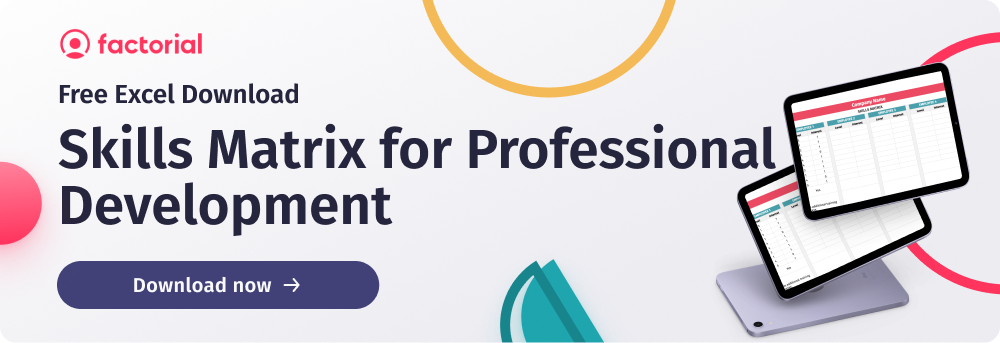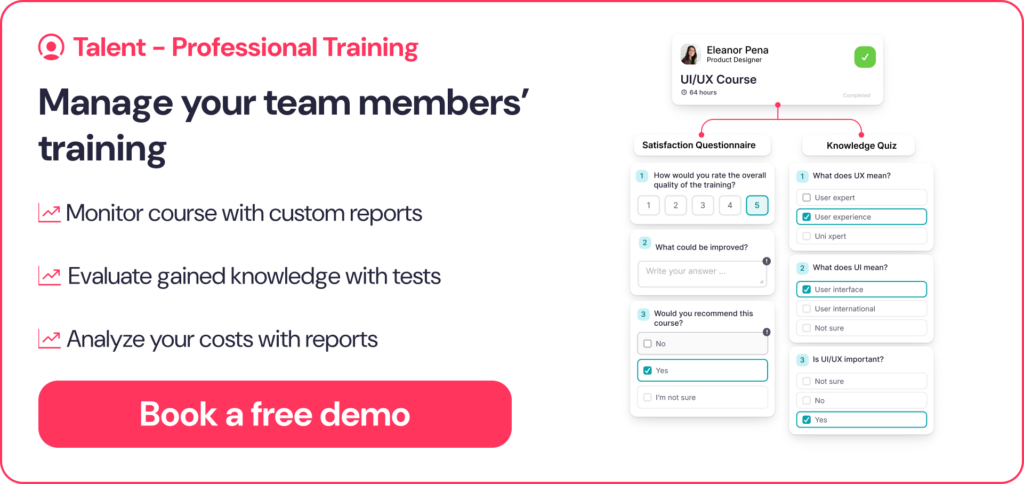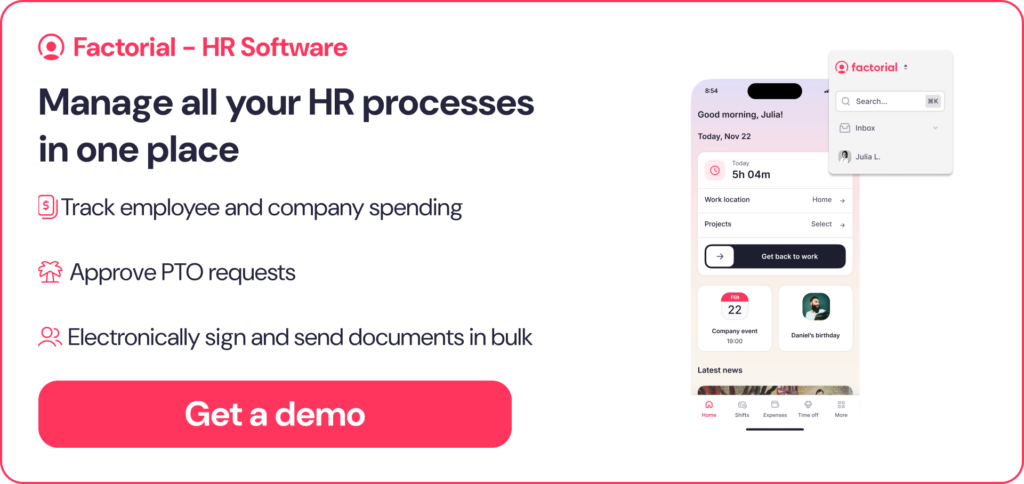Organisations are responsible for adopting L&D processes that help their employees to grow professionally, meet their targets, and overall, improve organisational performance.
HR teams and L&D professionals must help employees retain the information they’ve learned and apply it over time through engaging training methods.
There are a lot of things to consider when choosing a training method for your employee learning and development. The most important things to consider are the number of trainees, the budget, and the learning objectives.
In this article, we’ll share an overview of some of the most popular L&D training methods for your workplace.
What is L&D?
First things first, L&D stands for learning and development. The HR department is responsible for this process, which aims to develop employees’ skills, benefiting both the employee and the company they work for.
What are the benefits of L&D?
Through the implementation of a good HR L&D strategy in your workplace, you can expect the following benefits:
- Higher talent retention rates
- Positive employer branding, attracting more talent
- Higher levels of engagement from employees
- Improved employee performance
Investing in your existing employees’ skills through learning and development programs will have a significantly positive impact on your business as a whole.

Rather than outsourcing new candidates to fill skills gaps, you can spend time and money on your top talent. L and D help to keep the knowledge of your employees up to date, keeping them up with any trends which will later benefit the business as a whole.
L&D Methods
There are many different methods of delivering learning and development. Each organisation has their own unique culture, which influences how training is developed, delivered and received. Equally, how we learn best is unique to each individual, and universally applying one single technique is impossible.
There is a large variety of learning and development methods. We’re going to take a look at some of the most popular and well-tested techniques here.
70/20/10 Model for Learning & Development
The 70/20/10 model is well-known as a practical approach to delivering learning throughout an organisation. The model breaks down the main ways that learning happens into three different-sized sections:
70% = learning by doing (on-the-job experience such as new project or supervisor feedback)
20% = social learning (mentorship, coaching, peer discussions)
10% = formal learning (structured learning such as in a classroom, using e-learning or books)
Blending the different types of learning creates an approach that recognises the impact relationships and interactions with colleagues have on skills development, ensures a practical aspect to the training and supports development as a continuous experience within the flow of the work itself rather than a one-off.
Content Creation for L&D
Digital technologies for learning can be used to increase engagement, productivity, and training in the workplace. Depending on what you are teaching your employees, there are various ways that you can create content to show your employees how to perform certain tasks.
In the modern digital workplace, HR teams need to be able to create an effective training program and engage their employees.
Learning Styles & Software
- Verbal: You may choose to teach employees through a written approach. Using Microsoft Office or Google Docs, with written instructions and images.
- Aural: This is a very effective way of creating content, you can use these apps to record the process to show your employees step-by-step instructions. Apps such as loom and other video tools.
- Solitary: Using a virtual classroom. You can set assignments for your employees, allowing them to learn individually.
Instructor-led Training (ILT)
ILT is led by an instructor in a classroom or a similar environment. This is one of the most traditional training methods when it comes to L&D programmes. This method is used to give the trainees an overall understanding of the training topic. Due to how cost-effective and time-saving this approach is, it is one that is frequently used by employers.
Instructor-led training (ILT) is most effective when you need to provide a large group of learners with an overview of a topic. A key advantage of ILT is how interactive this approach is.
Employees can ask questions in real-time and receive instant answers to their queries. This type of learning is a good option for when trainer and trainee interaction is valuable.
E-Learning
E-learning is a great option for organisations that want to offer flexible learning opportunities for a global workplace or across virtual teams. This training method allows learning to take place at any time, date and device; laptops, smartphones, tablets, computers etc.
This learning approach can be delivered through a variety of interactive and engaging training programs. L&D professionals can also create a sense of gamification through virtual classrooms, games, videos, quizzes and more.
Due to the engaging nature of e-learning, this L and D method can be more effective for employees, helping them to better retain information. All in all, saving time and money.

On-the-job training (OTJ Training)
Generally, OTJ training is carried out by a more senior member of staff who demonstrates the required task to a less experienced employee. This is usually done on a one-to-one basis, where the trainer demonstrates what the task consists of allowing the trainee to immediately mimic what they have been taught.
This training approach is beneficial as the employee is immediately able to apply what they have been shown. And further practice what they have been taught with the help of the trainer. Through this direct learning and development method, employees can quickly learn from their mistakes and receive immediate feedback from the trainer.
Coaching and Mentoring for L&D
This training method involves knowledge sharing from different levels of the business. Using internal coaching and mentoring to enhance employees’ skills, knowledge and work performance. This can be done through a buddy system, partnering more senior employees with less senior members of the team to connect their skillsets and share knowledge.
This method of workplace training is beneficial for both the mentee and the mentor, enabling them to simultaneously gain new skills. It also helps to increase employee engagement and loyalty.
By adopting a mentoring program, you can create a learning and development lifecycle at work. Employees who have previously been mentored will later become a mentor for another member of the team. And the cycle will continue as your team changes, but you’ll retain vital knowledge within your company.
Cross Training
The cross-training model gives employees opportunities for development outside of their normal function. By exposing employees to alternative experiences to their usual role, cross-training can enhance skillsets and create a more versatile workforce.
Examples include:
- shadowing or mentorship to learn from colleagues in other departments
- job rotation where employees temporarily switch roles to learn about a different function
- working on specific projects which involve using different skills to normal
- Structured training sessions that teach new skills outside of what is required for the role
Targeted Training
As the name suggests, targeted training is a learning and development approach that focuses on addressing a specific skills gap for an individual or a broader vulnerability within the organisation that has been identified. An example of this might be introducing a new software system, which requires several departments to learn new skills to use it.
Targeted training is tailored to achieve a specific outcome. It is:
- Needs-based: the training responds to a clearly identified skills gap or performance issue.
- Audience-specific: the training is relevant to the individual or team that requires it.
- Goal-orientated: a clear and measurable objective is agreed upon before the training starts.
- Usually over a short period: the specific nature of the training often creates a timeframe for delivery that is brief and efficient.
- Focussed on relevant content: training is streamlined to focus entirely on the need to be addressed.

Learning in The Flow
This is a self-directed learning approach where employees access materials and resources when needed.
For example, if asked to complete an unfamiliar task, employees can use high-quality resources to learn and complete it independently.
While this approach has challenges, it benefits remote employees—especially those working different schedules than their team. Through this learning approach, employees may also be able to better internalise information. Familiarising themselves with the information when they need it, not through an overload of information.
Ultimately, employers need to upskill their employees to support the objectives of the organisation. As an employer, it’s important for employers to define their company strategies and to keep planning ahead in order to see what skills will be in-demand. As we mentioned, employers should invest in their existing talent, rather than looking elsewhere. Consequently, this will have a positive impact on the business as a whole, and most importantly, employee wellbeing and satisfaction.
Implementing a L&D Programme
If you are planning to implement a L&D Programme or are aiming to revamp your existing offering, it’s helpful to think about the following considerations:
- Start by identifying the skills gaps and how they align with your organisation’s goals.
- Think about what you know about your workforce: study performance reviews to identify gaps and get feedback so you understand what staff want and need from an L&D programme.
- Set SMART goals for the programme so everyone is clear on the aims and how they will be measured – and make sure measurement and accountability take place.
- Use different learning techniques to ensure the programme has the maximum impact on the workforce.
- Work with technology to offer remote or blended learning and in-person classroom learning.
- Ensure the programme is accessible to all, including those with specific needs in terms of their learning, location or roles.
- Encourage senior leadership to set a good example by taking on their own learning programme.
- Embed a culture of continuous learning into the business: celebrate when employees get involved with learning and showcase when the training directly impacts the individual or the wider business.
Tracking Learning Progress with Factorial
Keeping track of the logistics of a training programme can be challenging. In addition to the details of individual training programmes and whether they have been completed or not, it’s essential for companies to connect information on the training done with performance and whether it has had an impact on the business and the individual.
Factorial’s training management software streamlines the organisation of training sessions with attendance tracking, including reminders if training needs to be completed regularly. The software holds details of training files and certificates, provides links to performance reviews, and generates insight reports and KPIs to help ensure L&D meets the strategic needs of the business.
Also, our OKR software supports the implementation of an L&D programme as it allows the business to manage the setting of objectives on an individual level and helps drive a culture of continuous improvement by ensuring there are regular performance reviews and opportunities to reflect.
Book your FREE demo today to simplify your team’s training management.




